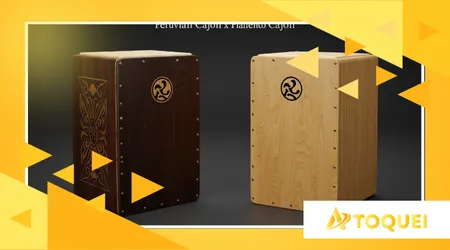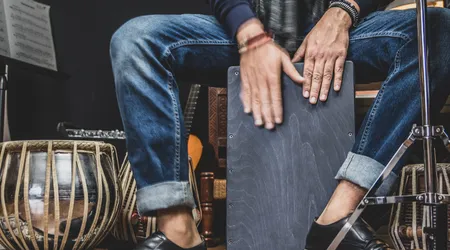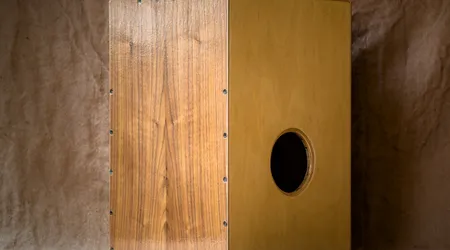Peruvian Cajón vs. Flamenco: Similarities, Differences, and Styles

Peruvian Cajon vs. Flamenco is a song that pulses with history, culture and rhythm, uniting two vibrant musical worlds.
Advertisements
Originating in Afro-Peruvian communities, the cajón conquered Spanish flamenco, creating a sonic bridge between continents.
This article delves into the roots, differences, and styles of these instruments, revealing how they shape musical genres and delight listeners.
With practical examples, real data, and a dash of curiosity, we'll explore what makes the cajón so unique. Have you ever wondered how a simple wooden box can carry so much soul?
The cajón's journey begins in Peru, where African slaves transformed shipping crates into instruments of cultural resistance.
Advertisements
In flamenco, it gained internal strings and a higher-pitched sound, adapting to the intense rhythms of Andalusia.
In 2025, the Peruvian Cajon vs. Flamenco remains in the spotlight, with festivals such as Cajonea 2025, which brings together Peru and Spain.
This text offers a rich guide for musicians, enthusiasts, and the curious, with insights into techniques, construction, and cultural influences. Get ready for a rhythmic journey!
Historical Roots: Where It All Began
On the Peruvian coast in the 19th century, the cajón emerged as a cry for freedom. African slaves, deprived of drums, used wooden boxes to create rhythms.
These sounds accompanied dances like the festejo, full of energy and soul. The instrument, simple yet powerful, became a symbol of Afro-Peruvian culture. In 2001, Peru declared the cajón a National Cultural Heritage Site.
The connection with flamenco came in the 1970s, when Paco de Lucía heard Caitro Soto play in Lima. Fascinated, he took the cajón to Spain, where Rubem Dantas adapted it.
THE Peruvian Cajon vs. Flamenco was born from this cultural exchange, with flamenco gaining a new rhythmic pulse. The cajón became essential in dances such as bulerías and tangos.
++ What Is a Waterphone? The Mysterious Sounds That Terrify the Movies
Today, the dialogue between Peru and Spain continues. The Cajonea 2025 Cajón Flamenco Festival in Málaga celebrates this fusion with concerts and workshops.
The story of Peruvian Cajon vs. Flamenco is a living example of how music transcends borders, uniting people in a shared rhythm.
This cultural exchange isn't just historic; it pulsates into 2025. Musicians like Latin Grammy-nominated Ernesto Hermoza elevate the cajón in global performances.
The instrument's richness lies in its ability to tell stories of resistance and innovation, connecting past and present.

Construction and Sound: What Sets Them Apart
The Peruvian cajón is a solid wood box, usually cedar, with a plywood front cover. Its sound is deep and warm, ideal for Afro-Peruvian rhythms.
With no internal strings, it relies on the musician's skill to vary tones. It's like a heart that beats strongly, but with subtle nuances.
See more: Discovering the Ocarina: From Zelda to Classical Music
The flamenco cajón, made of thinner plywood, incorporates internal strings or bordones, like those found on guitars. This creates a high-pitched, metallic sound that cuts through the flamenco rhythms.
THE Peruvian Cajon vs. Flamenco diverges here: the Peruvian seeks depth; the flamenco seeks precision. The table below summarizes the differences:
| Feature | Peruvian Cajon | Cajon Flamenco |
|---|---|---|
| Material | Solid wood, thick cover | Plywood, thin slap |
| Sound | Serious, hot | Sharp, metallic |
| Internal Strings | Does not have | It has borders |
| Main Use | Celebration, landó, marinera | Bulerías, tangos, rumba |
Musicians like Marco Oliveros explore hybrid cajones, with adjustable systems to switch between Peruvian and flamenco sounds.
These models reflect the versatility of the Peruvian Cajon vs. Flamenco in 2025, catering to artists who transition between genres.
See also: Kalimba: An African Instrument That Delights With Simplicity
Construction also influences transportation. The Peruvian cajón, more robust, is less portable than the flamenco, which prioritizes lightness.
This practical difference shapes musicians' choices on tour or in improvised performances.
Playing Techniques: Rhythm at Your Fingertips
Playing the Peruvian cajón requires strength and fluidity. Musicians use their hands and fingers to create low and mid-range sounds, similar to the festejo, which pulsates with energy.
The posture is relaxed, with an emphasis on natural grooves. It's like dancing with your hands, guided by your Afro-Peruvian heart.
In flamenco, the technique is more precise. The cajonero uses fingers, nudillos, and palms to create sharp, dry sounds, accompanying the taconeo.
Techniques like “rebounding” create complex rhythms. Peruvian Cajon vs. Flamenco shines in interaction with other instruments, such as the flamenco guitar.
Practical example: in Peruvian celebration, a rhythmic pattern can be “tum-tak-tum-pá”, with emphasis on the bass.
In flamenco, a bulería uses "tak-tik-tak-pá," with vibrating bordones. These differences demonstrate the richness of Peruvian Cajon vs. Flamenco in different styles.
Workshops, such as those at Cajonea 2025, teach these techniques. Musicians learn to alternate between Peruvian grooves and flamenco beats, enriching their repertoire. Consistent practice is essential to mastering both styles.
The cajón's versatility also shines through in jam sessions. A percussionist might start with a Peruvian landó and transition into a flamenco rumba, demonstrating how Peruvian Cajon vs. Flamenco unites musical worlds in real time.
Musical Styles: Where the Cajón Shines
The Peruvian cajón is the soul of genres such as the landó, with its sensual cadence, and the marinera, elegant and traditional.
Its deep sound embodies Afro-Peruvian dances. Artists like Susana Baca are bringing these rhythms to the world, with the cajón as the star.
In flamenco, the cajón accompanies dances such as soleá, bulería, and tangos, complementing clapping and tap dancing. Its presence intensifies the genre's raw emotion.
THE Peruvian Cajon vs. Flamenco can be found in shows like those of Ernesto Hermoza, which fuses both.
Original example: Imagine a duo in Lima, 2025. The cajonero plays a party, with deep beats, while a guitar strums a flamenco tango. The fusion is hypnotic, demonstrating the universality of Peruvian Cajon vs. Flamenco.
Actual data: According to Ibermúsicas (2024), 70% of flamenco percussionists use cajones with bordones, while in Peru, 8% prefer unstrung models. This statistic reflects distinct cultural choices.
Beyond traditional genres, the cajón is also permeating pop and jazz. Musicians like the group Perú Negro blend cajón with electronics, creating contemporary sounds that resonate at global festivals.
Cultural Influences and Modernity
The Peruvian cajón embodies Afro-Peruvian resistance, a legacy of struggle against colonial oppression. Its simplicity reflects the genius of transforming everyday life into art.
In 2025, it remains a symbol of national identity, celebrated in events such as Peruvian Cajón Day.
The cajón flamenco, on the other hand, is an Andalusian icon, but with global roots. Its adoption by Paco de Lucía demonstrates flamenco as a genre open to innovation. Peruvian Cajon vs. Flamenco is proof of cultural syncretism.
Analogy: The cajón is like a rope bridge, harmoniously connecting distant shores. Each stroke resonates with the stories of two peoples, uniting Peru and Spain in a shared rhythm.
Modern innovations include digital cajones, such as those from Roland, which simulate traditional sounds. These models appeal to young musicians, but purists champion handcrafted wood for its authenticity.
Festivals like Cajonea 2025 promote recycled cajón workshops, encouraging sustainability. These initiatives demonstrate how Peruvian Cajon vs. Flamenco evolves, maintaining its roots while embracing the future.
Choosing a Cajón: What's Your Style?

Choosing between the Peruvian cajón and flamenco depends on your musical goals. Want deep grooves for Afro-Peruvian dances? The Peruvian cajón is ideal. Do you prefer cutting rhythms for bulerías? Flamenco is the right choice.
Consider transportation: flamenco cajones are lighter and perfect for gigs. The robust Peruvian cajones shine in studios or permanent performances. Peruvian Cajon vs. Flamenco offers options for all contexts.
Original example: Ana, a percussionist from São Paulo, uses a hybrid cajón in world music concerts. She adjusts the strings to alternate between landó and rumba, captivating audiences.
Brands like Meinl offer affordable models, while luthiers like Flamentr3lok create handmade cajones. In 2025, personalization is trending, with musicians engraving names or designs on their instruments.
Before you buy, test the cajón. Feel the sound, the ergonomics, the weight. A good instrument is like a dance partner: it should respond to your touch with precision and passion.
Conclusion: A Rhythm that Unites Worlds
THE Peruvian Cajon vs. Flamenco It is more than a clash of instruments; it is a celebration of intertwining cultures.
From Peru to Spain, the cajón carries stories of resilience, innovation, and passion. In 2025, it pulsates in festivals, studios, and streets, uniting musicians and listeners in a universal rhythm.
Whether in the bass of the landó or the treble of the bulería, the cajón invites you to feel the rhythm. What will be the next stage for this magic box? Try, touch, discover!
Frequently Asked Questions
1. What is the main difference between the Peruvian cajón and flamenco?
Peruvian has a low sound, without internal strings, ideal for Afro-Peruvian rhythms. Flamenco, with bordones, produces high-pitched sounds, perfect for sticks like bulerías.
2. Can I use the same cajón for both styles?
Yes, hybrid cajones with adjustable strings allow you to switch between Peruvian and flamenco sounds, but purists prefer genre-specific instruments.
3. Where to learn to play the cajón in 2025?
Workshops like those at the Cajonea 2025 Festival in Malaga, or online classes with masters like Marco Oliveros, are great options for beginners and advanced learners alike.
4. Which cajon is best for beginners?
Models like the Meinl Mini-Cajón, at 40 euros, are lightweight, affordable, and ideal for practicing basic techniques before investing in a professional.
